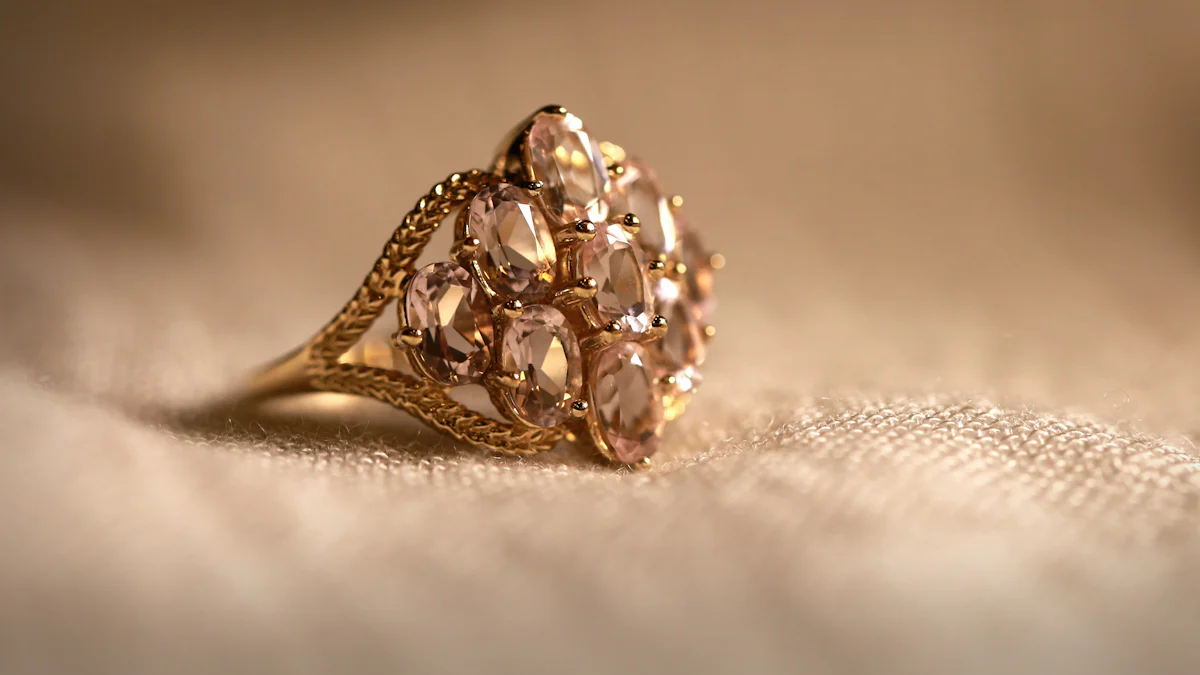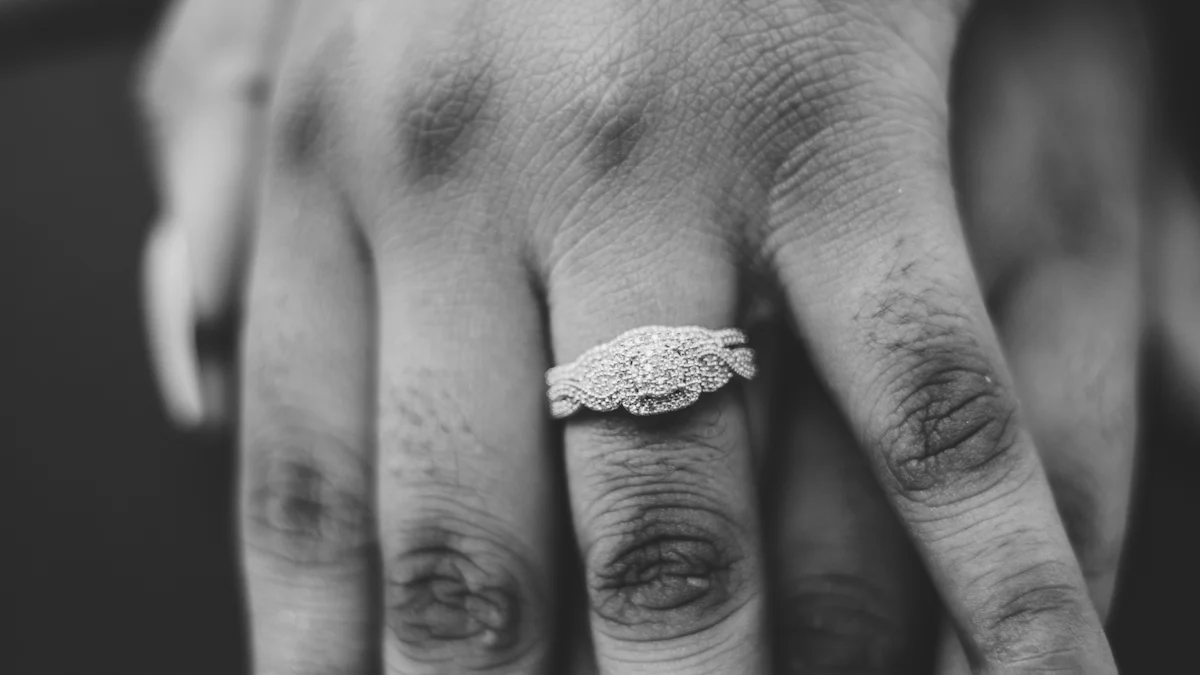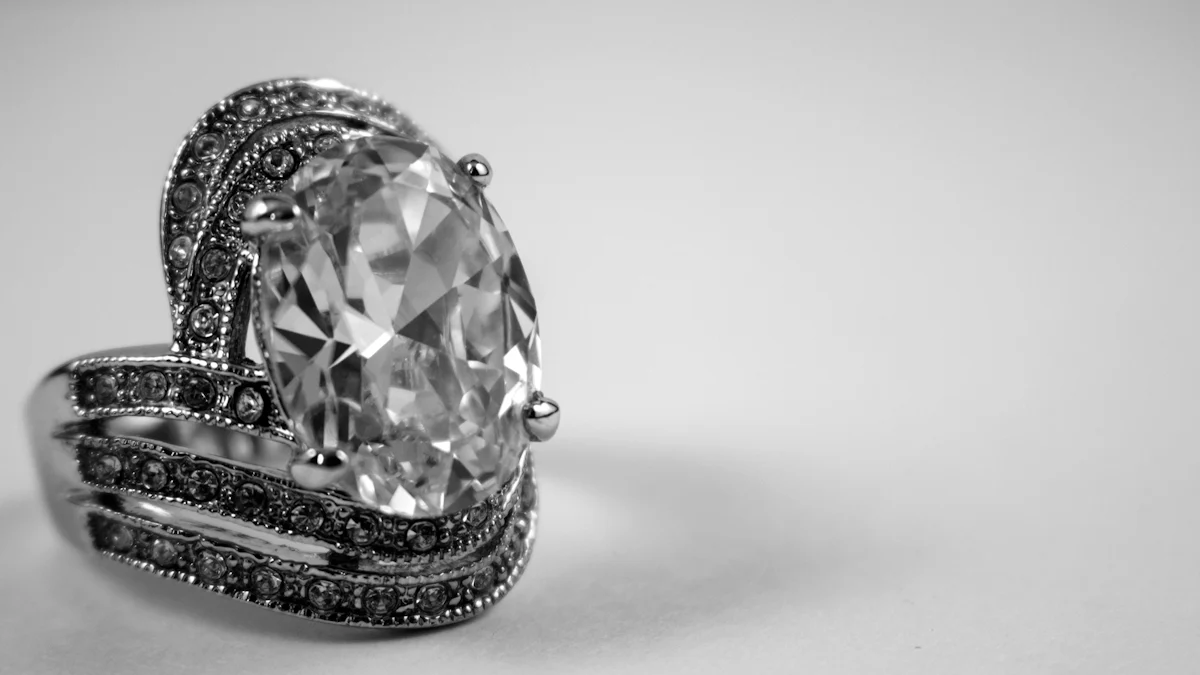Antique Wedding Rings 1920s: A Buyer’s Guide

Antique wedding rings 1920s hold a special allure that captivates many. These rings, influenced by the Art Deco era, showcase geometric designs and bold gemstone cuts. You’ll find that each piece tells a story, reflecting the craftsmanship and creativity of its time. The intricate patterns and use of colored gemstones make these antique wedding rings 1920s timeless treasures. When you choose a 1920s ring, you’re not just selecting jewelry; you’re embracing a piece of history with unmatched charm and elegance.
Understanding 1920s Antique Wedding Rings

Historical Context
The 1920s, often referred to as the Roaring Twenties, was a time of significant cultural and artistic change. This era saw the rise of the Art Deco movement, which left a lasting impact on various forms of art and design, including jewelry. When you explore antique wedding rings from the 1920s, you step into a world where modernist decorative styles flourished. These rings were influenced by the preceding Art Nouveau and Edwardian periods, blending floral motifs with sleek, geometric designs. The use of platinum and diamonds became more pronounced, reflecting the elegance and sophistication of the time.
Art Deco engagement rings from this period often featured bold, geometric patterns and were crafted with precision. The introduction of new diamond-cutting techniques allowed for innovative cuts that enhanced the geometric flair of these rings. You might find rings adorned with synthetic sapphires or rubies, adding a splash of color to the otherwise monochromatic palette. The 1920s rings were not just pieces of jewelry; they were statements of style and craftsmanship, each telling a unique story of its own.
Common Styles and Features
When you delve into the styles of antique wedding rings from the 1920s, you'll notice a distinct emphasis on geometric shapes and intricate details. Art Deco rings often showcased center diamonds set in square, octagonal, or hexagonal pronged settings. These settings were sometimes domed or stair-stepped, adding depth and dimension to the design. The shoulders and shanks of the rings were frequently embellished with engraved designs, reflecting the meticulous craftsmanship of the era.
Materials played a crucial role in defining the style of 1920s rings. Platinum and white gold were the metals of choice, providing a sleek and modern look. The rings often featured thin shanks, which were delicate yet sturdy. The use of colored stones, such as synthetic sapphires and rubies, added a vibrant touch to the otherwise monochrome designs. These elements combined to create rings that were not only beautiful but also representative of the artistic spirit of the time.
Evaluating Authenticity and Condition

When you're on the hunt for antique wedding rings from the 1920s, ensuring authenticity and assessing the condition are crucial steps. These factors not only affect the value but also the longevity of your cherished piece.
Identifying Authentic Pieces
To identify an authentic 1920s ring, start by examining the craftsmanship. Look for intricate details and geometric patterns typical of the Art Deco era. Barzilay Freund, an expert in antique and vintage rings, suggests buying from reputable dealers or vetted marketplaces. He emphasizes the importance of certificates of authenticity, especially for high-priced diamonds and gemstones.
"Stamps and hallmarks are another way to verify a piece’s authenticity and age," says Freund. However, be aware that resizing might remove these marks.
Consider seeking a professional appraisal. An expert can provide a thorough assessment and valuation, ensuring you get a genuine piece. Martinez, a specialist in diamonds and gemstones, recommends high-level laboratory reports for grading and identifying stones. She highlights the Gemological Institute of America (GIA) and American Gemological Laboratories (AGL) as reputable sources.
Assessing Condition
Once you've confirmed authenticity, assess the ring's condition. Antique rings often show signs of wear, which can add to their charm. However, you should ensure that any wear doesn't compromise the ring's integrity. Check for loose stones, worn prongs, or thin shanks. These issues might require repair, which could affect the ring's value.
Consult an appraiser who specializes in antique jewelry. They can evaluate the ring's condition, considering its age and historical context. As Martinez notes, an appraiser with expertise in vintage jewelry will know what to look for and how to assess your ring properly.
By taking these steps, you can confidently purchase a 1920s antique wedding ring that not only holds historical value but also stands the test of time.
Determining Value
When you're considering purchasing antique wedding rings from the 1920s, understanding what affects their value is crucial. These rings are not just beautiful pieces of jewelry; they are historical artifacts with unique stories.
Factors Affecting Value
Several factors can influence the value of a 1920s antique wedding ring:
-
Materials Used: The type of metal and gemstones used in the ring significantly impact its value. Rings from the 1920s often feature platinum or white gold, which were popular at the time. The presence of high-quality diamonds or rare gemstones can also increase a ring's worth.
-
Craftsmanship: The level of detail and skill involved in creating the ring plays a vital role. Art Deco rings are known for their intricate designs and geometric patterns. A well-crafted ring with fine details will generally be more valuable.
-
Condition: The ring's condition is another critical factor. While some wear and tear can add to the charm, significant damage or missing stones can decrease its value. It's essential to assess whether any repairs are needed and how they might affect the ring's overall worth.
-
Provenance: The history of the ring, including any notable previous owners or its origin, can add to its value. Rings with a documented history or those from renowned jewelers may fetch higher prices.
-
Rarity: Some designs or styles from the 1920s are rarer than others. A unique or hard-to-find piece can command a premium price.
Appraisal Tips
Getting an appraisal from a professional can help you determine the true value of a 1920s antique wedding ring. Here are some tips to consider:
-
Seek Expert Appraisal: Consult with a reputable antique jewelry expert or appraiser. They can provide a thorough assessment and valuation of the piece. As noted by Antique Jewelry Experts, "When in doubt, seek the expertise of a professional appraiser."
-
Discuss Repairs: If the ring requires repairs, discuss these with your appraiser before proceeding. According to Antique Jewelry Appraisal DC Professionals, repairs can impact the value, so it's essential to understand their implications.
-
Evaluate Gemstones: The color, clarity, cut, and carat of any gemstones in the ring are crucial to its value. An expert will use tools like a loupe to identify flaws and assess quality. The Antique Jewellery Company emphasizes the importance of these factors in determining a piece's worth.
-
Consider Certificates: For high-priced diamonds and gemstones, ask for certificates of authenticity from reputable laboratories. Barzilay Freund advises that stamps and hallmarks can also verify a piece's authenticity and age.
By understanding these factors and seeking professional guidance, you can make an informed decision when purchasing a 1920s antique wedding ring. This ensures you acquire a piece that not only holds historical significance but also retains its value over time.
Where to Buy
Finding the perfect 1920s antique wedding ring requires knowing where to look. You want to ensure you're getting an authentic piece that holds both historical and monetary value. Let's explore some trusted sources and red flags to watch out for.
Trusted Sources
-
Reputable Dealers: Start your search with well-known antique jewelry dealers. These experts often have a curated selection of 1920s rings and can provide valuable insights into each piece's history and craftsmanship. For instance, Cynthia Findlay Fine Jewellery & Antiques offers a stunning collection of 1920s engagement rings. Their Art Deco experts can assist you in finding the perfect ring, either by visiting their Toronto location or setting up an appointment.
-
Vetted Marketplaces: Online platforms like Etsy and eBay can be great places to find antique wedding rings from the 1920s. However, it's crucial to read seller reviews and ask questions about the ring's authenticity and condition. Ensure the seller offers a good return policy to protect your purchase.
-
Certificates of Authenticity: When buying high-priced diamonds or gemstones, look for certificates of authenticity from reputable laboratories. These documents verify the ring's age and authenticity, giving you peace of mind about your investment.
-
Antique Shops and Vintage Jewelry Stores: Local antique shops and vintage jewelry stores often have unique selections of 1920s rings. Visiting these places allows you to see the rings in person and assess their condition closely.
Red Flags
-
Lack of Documentation: Be wary of sellers who cannot provide documentation or certificates of authenticity. This lack of transparency can indicate a counterfeit or misrepresented piece.
-
Poor Condition: Examine the ring for signs of damage, such as chips, fractures, or worn metal. While some wear is expected, significant damage can affect the ring's value and longevity.
-
Unrealistic Prices: If a deal seems too good to be true, it probably is. Real antique rings are both expensive and delicate, so extremely low prices can be a red flag for fakes or replicas.
-
Inconsistent Descriptions: Pay attention to the seller's description of the ring. Inconsistencies or vague details can suggest a lack of knowledge or honesty about the piece.
By choosing trusted sources and staying alert to potential red flags, you can confidently purchase a 1920s antique wedding ring that is both beautiful and authentic.
As you explore the world of antique wedding rings from the 1920s, remember their unique charm and historical value. These rings, influenced by the Art Nouveau and Edwardian eras, showcase floral motifs and sleek designs. The use of platinum and diamonds, combined with geometric shapes, reflects the elegance and sophistication of the Roaring Twenties. By choosing a 1920s ring, you embrace a piece of history that stands as a testament to style and luxury. Consider these timeless treasures for their unmatched beauty and the stories they carry.
FAQ
What were the characteristics of 1920s wedding rings?
1920s wedding rings boasted geometric designs and vibrant colored stones. Art Deco engagement rings from this era often featured old-mine cut, European-cut, and brilliant-cut diamonds. These diamonds were primarily set in platinum or white gold. New diamond-cutting techniques introduced during this time allowed for innovative cuts that enhanced the geometric flair of the rings. You might notice synthetic sapphires or rubies accentuating these rings. The center diamond often sat in square, octagonal, or hexagonal pronged settings. Some Art Deco wedding ring settings were domed or stair-stepped. Engraved designs embellished the shoulders and shanks of these rings, adding intricate details.
What influenced the styles of 1920s engagement rings?
The styles of 1920s engagement rings drew heavy influence from the Art Nouveau and Edwardian eras. Early 1920s rings adopted floral motifs from the Art Nouveau movement but presented them in sleeker designs. From the Edwardian era, these rings retained the use of platinum and diamonds. However, they embraced more geometric shapes. Instead of the curved, flowing lines typical of Edwardian rings, 1920s rings showcased straight lines and distinct geometric shapes.
What were vintage wedding rings like during the Art Nouveau period?
Art Nouveau jewelry, which originated in France, introduced vintage wedding rings that many found both gorgeous and gaudy. These rings offered an alternative to the very delicate vintage wedding rings of the Edwardian era. The Art Nouveau period celebrated intricate designs and artistic expression, making these rings unique and eye-catching.
How can I identify an authentic 1920s wedding ring?
To identify an authentic 1920s wedding ring, examine the craftsmanship closely. Look for intricate geometric patterns typical of the Art Deco era. Authentic rings often feature high-quality materials like platinum and diamonds. Checking for stamps or hallmarks can also help verify a piece's authenticity and age. Consider consulting with a reputable antique jewelry expert for a professional appraisal.
What should I consider when assessing the condition of a 1920s ring?
When assessing the condition of a 1920s ring, look for signs of wear that might affect its integrity. Check for loose stones, worn prongs, or thin shanks. While some wear can add charm, significant damage might require repairs, impacting the ring's value. Consulting an appraiser who specializes in antique jewelry can provide a thorough evaluation.
Where can I buy authentic 1920s wedding rings?
You can find authentic 1920s wedding rings at reputable antique jewelry dealers, vetted online marketplaces like Etsy and eBay, and local antique shops. Ensure the seller provides documentation or certificates of authenticity. Reading reviews and asking questions about the ring's history and condition can also help ensure a trustworthy purchase.
What are some red flags to watch out for when buying a 1920s ring?
Be cautious of sellers who cannot provide documentation or certificates of authenticity. Examine the ring for significant damage, such as chips or worn metal. Unrealistic prices might indicate a counterfeit or misrepresented piece. Pay attention to the seller's description for inconsistencies or vague details.
How do I determine the value of a 1920s wedding ring?
The value of a 1920s wedding ring depends on several factors, including the materials used, craftsmanship, condition, provenance, and rarity. High-quality materials like platinum and diamonds, intricate designs, and a documented history can increase a ring's value. Consulting with a professional appraiser can provide an accurate valuation.
Can 1920s rings be resized?
Resizing 1920s rings can be challenging due to their intricate designs and delicate structures. It's essential to consult with a skilled jeweler experienced in working with antique pieces. They can assess whether resizing is possible without compromising the ring's integrity.
Why choose a 1920s wedding ring?
Choosing a 1920s wedding ring allows you to embrace a piece of history with unmatched charm and elegance. These rings reflect the artistic spirit of the Roaring Twenties, showcasing unique designs and craftsmanship. By selecting a 1920s ring, you acquire a timeless treasure that tells a story and holds historical significance.
See Also
Ultimate Tips for Selecting a Dual Purpose Ring
A Journey Through Global Wedding Ring Customs
Essential Tips for Choosing Engagement Rings for Men

